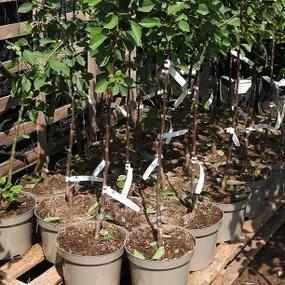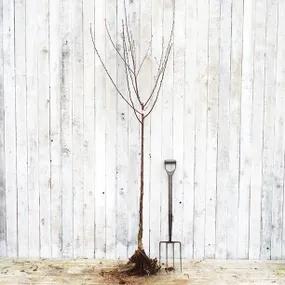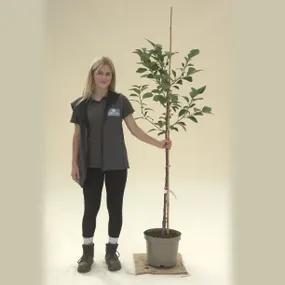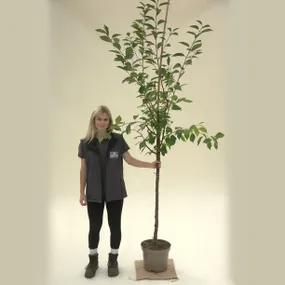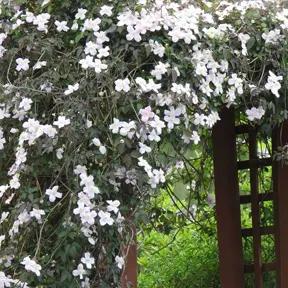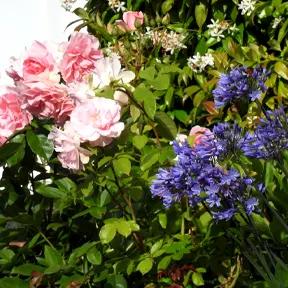'Morello' Sour Cherry Trees
- Cooking: sour cherry.
- Dark red.
- Self Fertile.
- Pollination Group F.
- Resistant to canker.
- Crops in August.
- RHS Award of Garden Merit
- Bareroot Delivery: Nov-March
Recommended extras
Description
Morello Acidic Cherry Trees: Jam - Late Season
Morello is the best sour cooking cherry for the UK, perfect for pies, jams or making alcohol.
Smaller than their sweet cousins, they are ripe for cooking when they turn dark red.
If you leave them on the branch until they are almost black, you can try eating them fresh - they are very acidic and not to everyone's taste!
The trees flower very late & tend to avoid late spring frosts.
They are recommended for Scotland and the North, as long as they get a half-decent dose of sun. They will fruit well on shadier north facing walls in the South.
Browse our range of cherry trees, or all our fruit trees.
Delivery season: Bareroot plants are delivered in late Autumn to Spring, about November-March inclusive. Pot grown plants, year round.
Features
- Self fertile.
- Pollination Group F.
- Resistant to canker.
- Avoid late spring frosts.
- Later fruit are less sour & can be eaten fresh.
- Freeze well.
- Crop in August.
- Recommended for the North and Scotland
Pollination Partners:
Morello is reliably self fertile, makes fruit all by itself, and it's a good pollinator for Kordia.
Rootstocks:
Our Morello cherry trees are all grown on "Colt" rootstocks.
Maximum height 4 metres.
Growing Morello Cherries:
Rich, well drained soil is ideal: dig in plenty of good manure and compost before planting.
The more sun your trees get, the better your crops will be, but Morello is good for growing as a fan against a North-facing wall.
Cherry trees are targets for birds, so netting them is a good idea.
Prune cherries in summer.
They fruit best on one-year-old wood, so yearly pruning to remove fruited wood and encourage new growth will give you the best crops.
Did You Know?
An old Kentish breed.
Before WW2, there were several sour cherry varieties in orchards, but today this is the only commercial variety, thanks to its disease resistance and good performance in poorer soil.
Cherry Tree Delivery Shapes:
Most of our fruit trees are delivered in up to 3 shapes (maiden, bush, and half standard), and you can buy selected varieties as potted mini patio trees: scroll up to see what's in stock.
Maiden: Unbranched tree, the most basic starting size, which you can train into the other forms (apart from mini patio trees).
Bush: Freestanding tree with a short trunk about 60cm tall. It will grow to about 3m. Ideal for small gardens.
Half-Standard: A freestanding form with a trunk about 120cm tall. It will grow into a full sized, "normal" cherry tree, about 4m. Ideal for orchards, easy to mow underneath.
Guide to Fruit Tree Sizing.
Planting Instructions
Prepare your site before planting:
Improving the soil helps trees establish quickly and be productive for years. Preparing weeks or months in advance gives best results: fill the planting hole back up, don't leave it open to either dry out or fill with water.
- Destroy weeds and grass,
- Dig the soil over, remove stones, then mix in well rotted compost or manure down to the depth of about 2 spades, unless you are on heavy clay:
- On thick clay soil, only dig in some grit to improve drainage and raise the level a little. Then apply organic matter as a mulch over the soil as normal.
Spacing cherry trees
- Freestanding bushes: 15-18 feet (5-6m) between trees and rows.
- Freestanding half-standards: 18-30 feet (6-10m) between trees and rows.
In general, allow 1 more metre between rows than between trees along the row.
- Wire-trained fans: 10-18 feet (3.5-6m) apart.
- Watch how to plant a fruit tree for a bush or half-standard.
- To grow a fan, you need to install sturdy training wires.
Remember to water establishing trees during dry weather for at least a year after planting.
Accessories:
For bush and half standard trees, a tree planting pack, which includes a wooden support stake & rubber tie (a bamboo cane is enough support for a maiden), and a biodegradable mulch mat, with pegs, to preserve soil moisture stops and prevent weeds.
We strongly recommend using mycorrhizal "friendly fungi" on the roots of all transplanted trees.
Winter wash and grease are effective, organic pest prevention.
It's Summer Planting Season 2025

Pot Grown & Plug Plants Delivered

Direct from the Nursery Value

No more broken plants in the post!


 1.webp)
 1.webp)
 2.webp)
 3.webp)
